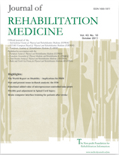
JOURNAL OF REHABILITATION MEDICINE
Scope & Guideline
Transforming Rehabilitation Science for a Healthier Tomorrow
Introduction
Aims and Scopes
- Rehabilitation Interventions and Techniques:
The journal focuses on innovative rehabilitation strategies and techniques, such as physical therapy, occupational therapy, and advanced modalities including robotic rehabilitation and virtual reality. - Clinical Outcomes and Effectiveness:
Research published in the journal often assesses the clinical effectiveness of rehabilitation interventions, focusing on outcomes such as functional independence, quality of life, and patient satisfaction. - Disability and Functioning Assessment:
The journal emphasizes the importance of assessing disability and functioning using standardized measures and frameworks such as the International Classification of Functioning, Disability, and Health (ICF). - Multidisciplinary Approaches:
The journal advocates for interdisciplinary collaboration in rehabilitation, highlighting studies that involve multiple healthcare professionals to address complex patient needs. - Population-Specific Rehabilitation:
A significant focus is placed on rehabilitation strategies tailored to specific populations, including stroke survivors, patients with spinal cord injuries, and individuals recovering from COVID-19.
Trending and Emerging
- Telehealth and Remote Rehabilitation:
The COVID-19 pandemic has accelerated the development and acceptance of telehealth services in rehabilitation, leading to increased research on remote rehabilitation interventions and their effectiveness. - Innovative Technologies in Rehabilitation:
There is a rising trend in the exploration of technologies such as virtual reality, robotics, and wearable devices to enhance rehabilitation outcomes, indicating a shift towards integrating technology into practice. - Psychosocial Aspects of Rehabilitation:
Recent studies increasingly focus on the psychosocial factors affecting rehabilitation, such as mental health, social support, and patient engagement, underscoring the holistic approach to rehabilitation. - Personalized Rehabilitation Approaches:
Emerging research highlights the importance of individualized rehabilitation plans tailored to the specific needs and preferences of patients, promoting better engagement and outcomes. - Multimodal Rehabilitation Strategies:
An increasing number of studies are examining the effectiveness of multimodal approaches that combine various rehabilitation techniques to address complex patient needs.
Declining or Waning
- Traditional Rehabilitation Techniques:
There is a noticeable decrease in studies focusing solely on traditional rehabilitation methods, such as basic physiotherapy exercises, as more advanced and evidence-based approaches gain prominence. - Longitudinal Studies on General Rehabilitation:
Research that broadly examines long-term rehabilitation outcomes without a specific focus on innovative interventions or technologies appears to be less frequent, indicating a shift towards more targeted studies. - General Population Studies:
Studies that analyze rehabilitation outcomes in broad, non-specific populations are declining, as the journal increasingly emphasizes research that addresses specific conditions or populations.
Similar Journals

JOURNAL OF BACK AND MUSCULOSKELETAL REHABILITATION
Elevating standards in back and musculoskeletal care.JOURNAL OF BACK AND MUSCULOSKELETAL REHABILITATION, published by IOS PRESS in the Netherlands, serves as a vital resource for researchers and practitioners in the fields of orthopedics, physical therapy, and rehabilitation. Since its inception in 1992, this peer-reviewed journal has been committed to advancing knowledge in the prevention and treatment of musculoskeletal disorders, showcasing high-quality research and clinical studies. With a commendable category ranking of Q2 in Physical Therapy and Rehabilitation, as well as Q3 in Orthopedics and Sports Medicine, the journal has established itself as an influential platform in the academic community, holding a Scopus rank that underscores its relevance and impact. While currently not an open-access publication, it offers insightful contributions that are pivotal for improving clinical practices and patient outcomes. The journal's ongoing commitment to excellence is reflected in its focus on the latest methodologies and therapeutic interventions, making it an essential reading for those dedicated to pushing the boundaries of musculoskeletal health.

Physiotherapy Practice and Research
Driving excellence in rehabilitation sciences.Physiotherapy Practice and Research is a pivotal journal published by IOS PRESS that focuses on the dynamic field of rehabilitation and physiotherapy. Since its inception in 2009, this journal has provided a scholarly platform for researchers, clinicians, and students to disseminate innovative findings and practical applications in occupational therapy, sports medicine, and rehabilitation sciences. Although the journal currently holds Q3 and Q4 rankings in several categories, including occupational therapy and physical therapy, its impact in fostering research collaboration and informing practice is becoming increasingly important in advancing patient care and rehabilitation outcomes. With an ongoing commitment to open-access principles, the journal welcomes original research and review articles that address contemporary challenges and emerging practices within the field. As the journal continues to evolve, it aims to engage more deeply with the global research community, unlocking vital discussions that shape the future of physiotherapy.

European Journal of Physical and Rehabilitation Medicine
Elevating Standards: Where Research Meets Rehabilitation PracticeWelcome to the European Journal of Physical and Rehabilitation Medicine, the premier peer-reviewed journal focusing on advancements in the fields of physical therapy, sports therapy, and rehabilitation. Published by EDIZIONI MINERVA MEDICA, this journal has established itself as a leading resource since its inception in 2008, now enjoying an impressive Q1 ranking in these disciplines according to 2023 metrics. With an emphasis on rigorous research and innovative clinical practice, the journal facilitates the dissemination of high-quality, evidence-based studies, contributing to the enhancement of patient care and therapeutic strategies. As an Open Access platform since 2022, the journal widens its reach, enabling researchers, clinicians, and students across the globe to access valuable insights without barriers. Residing in Italy, the journal's focus transcends regional confines, engaging a vibrant international community aimed at improving rehabilitation outcomes. Join us in exploring the latest developments that shape the future of rehabilitation sciences.

NEUROREHABILITATION
Elevating clinical standards through rigorous neurorehabilitation studies.Welcome to NEUROREHABILITATION, a premier journal dedicated to advancing the field of rehabilitation, specializing in neurology and physical therapy. Published by IOS PRESS, the journal has established itself as a crucial platform for disseminating high-quality, peer-reviewed research since its inception in 1991. Located in the Netherlands, NEUROREHABILITATION has achieved significant recognition within the academic community, reflected in its impressive impact factor and Scopus rankings, including a Q2 categorization in Rehabilitation and Physical Therapy, highlighting its relevance and influence in these essential domains. With a commitment to enhancing clinical practices and outcomes for individuals with neurological conditions, this journal serves as an invaluable resource for researchers, clinicians, and students alike. Although it currently operates under a subscription model, NEUROREHABILITATION continues to contribute meaningfully to the ongoing dialogue in rehabilitation sciences, making it a key player in shaping the future of therapy and patient care.
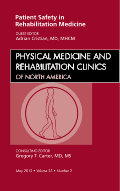
Physical Medicine and Rehabilitation Clinics of North America
Advancing rehabilitation through innovative research.Physical Medicine and Rehabilitation Clinics of North America is a leading journal published by W B Saunders Co-Elsevier Inc., focusing on the multifaceted disciplines of physical medicine, rehabilitation, and related health professions. With an impressive impact factor reflecting its significant contribution to the field, this journal ranks in the Q2 quartile for both Physical Therapy and Rehabilitation categories. The journal, available in both print (ISSN: 1047-9651) and online (E-ISSN: 1558-1381), provides critical insights, clinical updates, and comprehensive reviews that are essential for researchers, practitioners, and students alike. Covering a wide spectrum of topics from innovative rehabilitation techniques to emerging trends in sports medicine, it aims to disseminate knowledge that enhances patient care and drives advancements in rehabilitation practices. With a publication history spanning from 1995 to 2024, Physical Medicine and Rehabilitation Clinics is an essential resource for those dedicated to improving functional outcomes and the quality of life for patients worldwide.
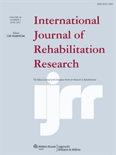
INTERNATIONAL JOURNAL OF REHABILITATION RESEARCH
Connecting research and practice to enhance rehabilitation strategies.INTERNATIONAL JOURNAL OF REHABILITATION RESEARCH, published by Lippincott Williams & Wilkins, stands as a vital resource within the fields of rehabilitation and physical therapy. With an ISSN of 0342-5282 and an E-ISSN of 1473-5660, this peer-reviewed journal has been disseminating groundbreaking research since its inception in 1978. As of 2023, it holds commendable rankings with a Q3 in Medicine (miscellaneous) and Q2 in both Physical Therapy, Sports Therapy, and Rehabilitation, as well as Rehabilitation, highlighting its significant contribution to these disciplines. The journal seeks to advance knowledge and practice in rehabilitation by serving as a platform for high-quality research, clinical studies, and theoretical discussions. It is particularly valuable for researchers, healthcare professionals, and students aiming to stay at the forefront of rehabilitation science and practice. Although not designated as open access, the journal remains accessible through various academic databases, ensuring that its content reaches a broad audience committed to improving rehabilitation therapies and outcomes.

Turkish Journal of Physiotherapy Rehabilitation-Turk Fizyoterapi ve Rehabilitasyon Dergisi
Championing progress in physiotherapy and rehabilitation.The Turkish Journal of Physiotherapy Rehabilitation (Turk Fizyoterapi ve Rehabilitasyon Dergisi), published by the TURKEY ASSOC PHYSIOTHERAPISTS, stands as a significant platform for the dissemination of research and developments in the fields of physiotherapy, rehabilitation, orthopedics, and sports medicine. Since its inception in 2018, the journal has been dedicated to advancing the understanding and practice of rehabilitation therapies, contributing valuable insights to both clinicians and researchers alike. Currently classified in the Q4 category across various relevant fields, including Orthopedics, Sports Medicine, and Physical Therapy, it reflects the evolving landscape of rehabilitation science. Although the journal is indexed in Scopus with ranks indicating its nascent stage, it serves as an essential resource for the academic community in Turkey and beyond. Researchers and professionals interested in innovative rehabilitation practices and advancements are encouraged to utilize this open access journal to share knowledge, fostering collaboration and growth within this critical area of healthcare.
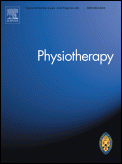
Physiotherapy
Empowering Professionals with Cutting-Edge KnowledgePhysiotherapy, published by Elsevier Science Ltd, stands as a prestigious journal in the field of Physical Therapy, Sports Therapy, and Rehabilitation. Since its inception in 1945, this journal has been committed to advancing the practice and science of physiotherapy through rigorous peer-reviewed research, making significant contributions to both clinical practice and academia. With an impressive Q1 ranking and a Scopus percentile of 88th, it is widely regarded as a leading source of evidence-based information for professionals and researchers alike. The journal operates without an Open Access option, which ensures that it maintains the quality and integrity of the research it publishes while providing exclusive access to valuable insights for its subscribers. By focusing on diverse topics within its scope, including therapeutic techniques, rehabilitation strategies, and sports medicine, Physiotherapy continues to shape the future of physiotherapy practice and education, making it an essential resource for anyone invested in this dynamic field.

Rehabilitation Oncology
Elevating Quality of Life for Cancer SurvivorsRehabilitation Oncology, published by Lippincott Williams & Wilkins, is an essential academic journal dedicated to the interdisciplinary field of cancer rehabilitation. Since its inception in 2008, it has provided a platform for illuminating research, clinical practices, and innovative therapies aimed at improving the quality of life for cancer survivors. With an ISSN of 2168-3808 and an E-ISSN of 2381-2427, the journal covers a wide spectrum of topics, making significant contributions across various categories including Oncology, Rehabilitation, and Physical Therapy. Although currently not Open Access, the journal has garnered a notable 2023 Impact Factor status, placing it in the Q3 quadrant across multiple relevant disciplines as per the latest Scopus rankings. This reflects its growing influence in the rehabilitation community and offers vital insights for practitioners and researchers seeking to advance their understanding of patient care post-cancer treatment. With its focus on bridging the gap between research and real-world application, Rehabilitation Oncology serves as a vital resource for healthcare professionals committed to enhancing recovery outcomes in their patients.
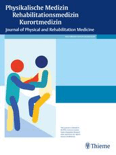
PHYSIKALISCHE MEDIZIN REHABILITATIONSMEDIZIN KURORTMEDIZIN
Empowering Recovery: Insights from the Heart of Rehabilitation SciencePHYSIKALISCHE MEDIZIN REHABILITATIONSMEDIZIN KURORTMEDIZIN, published by GEORG THIEME VERLAG KG, is a prominent journal dedicated to the fields of physical medicine, rehabilitation, and resort medicine. With its ISSN of 0940-6689 and E-ISSN 1439-085X, this journal has been at the forefront of disseminating essential research and innovative practices since its inception. Operating from Germany, it offers a crucial platform for professionals, researchers, and students engaged in exploring the latest advancements in rehabilitation methodologies and therapeutic practices. Although it currently holds a Q4 ranking in several categories including Physical Therapy and Rehabilitation, the journal is committed to enhancing its impact and visibility within the academic community. The journal publishes research, reviews, and clinical studies aimed at improving patient outcomes and advancing the science of rehabilitation. Subscribers can expect high-quality content that addresses both theoretical and practical aspects of rehabilitation medicine, ultimately contributing significantly to ongoing discussions and developments in the field.